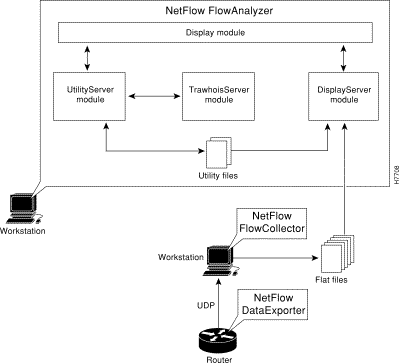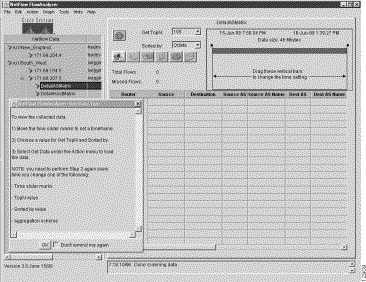|
|

NetFlow FlowAnalyzer Version 2.0 is a network analysis tool that you can use to display and analyze network traffic information collected from Cisco NetFlow-enabled devices running NetFlow services software.
NetFlow FlowAnalyzer Version 2.0 requires the use of Cisco IOS Release 11.1CC or 11.1(11)CA (or later) running on Cisco NetFlow-enabled devices.
Cisco IOS software provides enhanced security, quality of service, and traffic management capabilities in a NetFlow services environment. Related network services are based on traffic flows between network layer address pairs that are visible to the NetFlow FlowCollector application.
NetFlow FlowAnalyzer Version 2.0 has been expressly designed to operate with NetFlow FlowCollector Version 2.0. However, for the benefit of users of previous versions of these applications, it is important to note the following:
(a) The AS Drill Down window (see the section entitled "Drilling Down on Network Flows" in Chapter 3).
(b) The Search Window (see the section entitled "Searching for Flows by Source and Destination Addresses" in Chapter 3).
NetFlow services provide high-performance, network-layer switching that enables you to capture, display, and analyze a rich set of statistics gathered from network traffic flows. Such information includes:
NetFlow data being exported by NetFlow-enabled devices in your network to host FlowCollector workstations can be retrieved and used for a variety of purposes, such as the following:
NetFlow services also facilitate the processing of security access lists. It is much more efficient in this regard than other switching methods.
In both NetFlow services and conventional switching services, the first packet in a traffic flow undergoes fairly complex processing that involves switching, security, queuing, and accounting tasks.
In conventional switching, every subsequent packet in a traffic flow undergoes the same complex processing as the first packet. However, in NetFlow services, subsequent packets in a traffic flow are processed faster due to the inherent efficiency of the NetFlow services software.
The NetFlow system (see Figure 1-1) enables you to retrieve and analyze NetFlow data that has been collected from NetFlow-enabled devices in your network. The FlowCollector application, running on a designated workstation in your network, is the means by which the NetFlow information is collected and made available for use by the FlowAnalyzer Display module.
The FlowCollector stores this information in a locally managed database that can be accessed on-demand by means of user commands issued at the Display module console.
The NetFlow system has three main components:
The Display module of the FlowAnalyzer (see Figure 1-1) provides a graphical user interface (GUI) for the NetFlow system. This module enables you to select a data set (a collection of NetFlow traffic information) pertaining to a single router in the network or to multiple routers in the network and to display the information in a particular format (a defined aggregation scheme).
The FlowCollector application supports a variety of NetFlow data aggregation schemes, any one of which can be selected at any time to display applicable Netflow data for any router of interest.
You use the Netflow Data area of the Display module window (see Figure 3-4) to select any aggregation scheme currently applicable to a network router of interest. You can then issue appropriate Display module commands to initiate the display of relevant NetFlow data.
The NetFlow system thus provides a powerful tool for analyzing network traffic flows involving network routers. You can use the data gathered from such routers to better balance network loading, resolve network problems, and optimize network performance.

The components of the NetFlow system are described in greater detail in the following sections.
The export of NetFlow data is accomplished by native functionality within Cisco IOS software that is running on NetFlow-enabled devices in your network. This functionality supports the bulk export of NetFlow traffic data to designated FlowCollector workstations in your network.
A summary of traffic statistics for all expired router traffic flows can be exported on a periodic basis (by means of UDP datagrams) to a designated workstation in your network that is running the FlowCollector application (see Figure 1-1).
The FlowCollector collects traffic data being exported from network routers and stores the data in a designated local directory. Hence, the primary role of the FlowCollector is to maintain a database of NetFlow data files. This database can be accessed on demand by the DisplayServer module to retrieve NetFlow data on behalf of the Display module. You then issue appropriate commands at your Display module console to display the requested NetFlow data.
The FlowCollector application supports fast, scalable, reliable, and economical collection of NetFlow data that is being exported from multiple NetFlow-enabled devices in your network.
The collected NetFlow data is stored on a designated FlowCollector workstation in the network for later retrieval, display, and analysis by means of the Display module of the FlowAnalyzer application.
Important FlowCollector functions include the following:
The following sections describe functions of the FlowCollector application in greater detail.
NetFlow data records contain detailed traffic information for expired network traffic flows. Such information includes statistics about Layer 3 source and destination nodes in the network, down to the level of the individual applications and protocols participating in end-to-end communications within the network.
The ability to collect, display, and analyze detailed network traffic statistics provides the following benefits:
Traffic statistics can include any one or all of the following types of information:
The FlowCollector application collects detailed traffic statistics and aggregates (summarizes) the data according to one or more of the following aggregation schemes:
For detailed descriptions of the NetFlow data aggregation schemes, see the section entitled "Drilling Down on Network Flows" in Chapter 3.
To customize traffic statistics for display and analysis purposes, you can apply the following types of filters to the NetFlow data being stored by the FlowCollector application:
Figure 1-2 shows a typical topology for a network that incorporates NetFlow-enabled devices that are exporting Netflow data to a designated FlowCollector workstation in the network.
NetFlow-enabled devices deliver NetFlow data to the IP address and UDP port number of designated FlowCollector workstations in your network.
After you configure and start the FlowCollector application, it listens to the UDP ports of the NetFlow-enabled devices in your network to collect the traffic data being exported by such devices by means of UDP datagrams.

The FlowAnalyzer application is a network analysis tool that combines a graphical user interface with other companion modules. Together, these components enable you to retrieve, display, and analyze NetFlow data that has been collected from specified NetFlow-enabled devices in your network.
The individual modules of the FlowAnalyzer application are described in the following sections.
The Display module is a stand-alone Java application that can be installed and run on workstations or PCs in your network. This module provides an easy-to-use, graphically oriented user interface to the NetFlow system. You can install any number of Display modules into your network, as appropriate for your particular NetFlow data retrieval and analysis requirements.
The Display module can present NetFlow data in a variety of formats, including the following:
In addition, the Display module incorporates a number of facilities that help you to use the FlowAnalyzer application conveniently and effectively. Such user aids include the following:

Other user-oriented pull-down menus and buttons incorporated into the Display module window will be covered in Chapter 3, which describes how to use the FlowAnalyzer for a wide variety of NetFlow data retrieval and analysis tasks.
A DisplayServer module running on a host workstation in your network receives and acts on requests for Netflow data that you issue at the console of a Display module. You can configure any number of DisplayServer modules into your network, as appropriate, to act on user requests for NetFlow data.
The DisplayServer module responds to such user requests by accessing the NetFlow data files stored on a designated FlowCollector workstation in the network and transmitting the requested data to the Display module for presentation on the screen of a host workstation or PC. The Display module formats the data on the screen according to the selected aggregation scheme.
The UtilityServer module provides host and autonomous system (AS), as well as device interface information to the FlowAnalyzer.
The TrawhoisServer module receives requests from the UtilityServer module to perform AS translation tasks. In response, the TrawhoisServer module returns AS names (as contained in the router arbiter database) to the UtilityServer module.
"Trawhois" is an acronym for trivial routing arbiter whois.
|
|